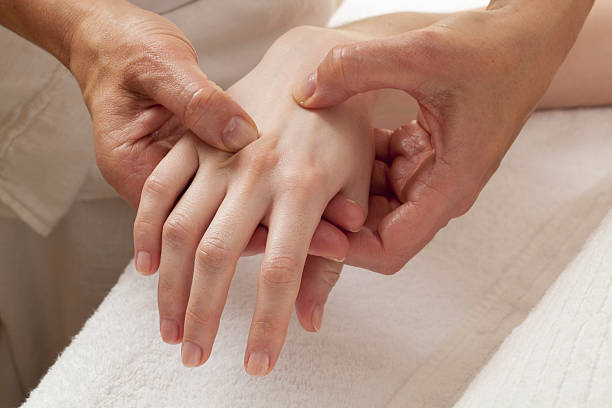
Carpal Tunnel Syndrome - Efficient and Effective Massage
By addressing the entire pathway, therapists alleviate the root causes of pain and ensure comprehensive relief for Carpal Tunnel Syndrome (CTS).
Comprehensive Treatment for Carpal Tunnel Syndrome: From Neck to Hands
Successful massage therapists treat muscles from the neck to the hands because many nerve pathways and muscle groups interconnected along this route can contribute to pain and dysfunction in the hands and wrists.
Issues in the neck, such as tension, poor posture, or nerve compression, can exacerbate or even cause symptoms in the lower arms, wrists, and hands. By addressing the entire pathway, therapists alleviate the root causes of pain and ensure comprehensive relief for Carpal Tunnel Syndrome (CTS).
Iler Method® therapists in Austin, TX, utilize trigger point therapy to efficiently treat these interconnected areas, helping to relieve pain and discomfort in muscles and joints. Trigger point therapy involves identifying and releasing tight knots in the muscles, which can refer to pain in other areas. Referred pain spots are also treated as they contribute to the effects of CTS.
By systematically addressing trigger points and referring pain from the neck to the hands, our therapists reduce chronic muscle tension and pain, improve nerve function, and enhance overall mobility. This holistic approach ensures that clients receive effective and efficient conservative treatment, addressing their pain and discomfort symptoms and underlying causes.
This non-surgical treatment option is a viable option for those experiencing symptoms of CTS, as it can provide symptom relief and improve daily activities without the need for carpal tunnel surgery.

Symptoms of Carpal Tunnel Syndrome
Numbness and Tingling: A frequent sensation of numbness or tingling in the thumb, index finger, middle finger, and part of the ring finger. This symptom is common among pregnant women and older people, who may already be at higher risk for musculoskeletal disorders.
Pain in the Wrist and Hand: Persistent pain in the wrist that may extend to the hand and fingers, often worsening at night. This painful condition can significantly impact general health and daily activities.
Weakness in the Hand: A noticeable weakness in the hand makes it difficult to grasp or hold objects securely. This symptom often affects older people and those with musculoskeletal disorders.
Burning Sensation: A burning sensation that travels from the arm to the fingers, often indicating issues with the median nerve and blood supply.
Shock-like Sensations: Sudden, shock-like sensations radiate to the fingers, particularly the thumb, index finger, and middle fingers. This symptom can be statistically significant in diagnosing CTS.
Difficulty with Fine Motor Skills: Difficulty performing tasks that require fine motor skills, such as buttoning a shirt or manipulating small objects. This is particularly impactful for older people and those in professions requiring precise hand movements.
Swelling Sensation: A feeling of swelling in the fingers, even if there is no visible swelling. Due to fluid retention, this can be more prevalent in pregnant women.
Worsening Symptoms at Night: Worsening Symptoms at Night: These symptoms worsen at night, sometimes waking individuals.
Recognizing these symptoms early and understanding the highest risk factors, such as pregnancy, age, and existing musculoskeletal disorders, is crucial for effective treatment and overall health.

What is Carpal Tunnel Syndrome?
Carpal Tunnel Syndrome (CTS) occurs when the median nerve, which runs from the forearm into the palm, becomes compressed or squeezed at the wrist. The carpal tunnel is a narrow, rigid passageway of ligaments and bones at the base of the hand, which houses the median nerve and the tendons responsible for bending the fingers. When the tissues surrounding these tendons swell, they can press on the median nerve, leading to CTS.
The median nerve is crucial for providing sensation to the thumb, index, middle, and part of the ring fingers and for controlling some small muscles at the base of the thumb. Compression of this nerve within the carpal tunnel can interfere with its normal function, leading to the characteristic signs and symptoms associated with Carpal Tunnel Syndrome.

Diagnosis of Carpal Tunnel Syndrome (CTS) typically involves a combination of physical examinations, patient history, and sometimes nerve conduction studies to confirm the compression of the median nerve. This can only be diagnosed by a doctor, who can differentiate it from other conditions such as thoracic outlet syndrome, which involves compression of nerves or blood vessels in the thoracic outlet, or inflammatory diseases that cause similar symptoms.
Accurate diagnosis of CTS by a doctor is critical because Carpal Tunnel Syndrome affects not only the ability to perform daily tasks but can also significantly impact one's quality of life if not properly treated. Proper diagnosis ensures the appropriate treatment plan is developed to address the symptoms' specific causes and provide relief.
Causes of Carpal Tunnel Syndrome
Repetitive Hand Movements -
Frequent, repetitive hand and wrist motions, such as typing and phone/tablet use, can contribute to developing Carpal Tunnel Syndrome (CTS). These activities can cause inflammation and swelling of the tendons within the carpal tunnel, leading to compression of the median nerve.
Wrist Injuries -
Injuries to the wrist, such as sprains, fractures, or dislocations, can alter the structure of the carpal tunnel and place additional pressure on the median nerve. Scar tissue from such injuries can also accumulate in the carpal tunnel, further contributing to nerve compression.
Health Conditions -
Certain health conditions, such as diabetes, rheumatoid arthritis, and thyroid gland imbalances, can increase the risk of CTS. These conditions can cause swelling and inflammation in the wrist area, narrowing the carpal tunnel and compressing the median nerve.
Pregnancy -
Hormonal changes during pregnancy can lead to fluid retention, which can cause swelling in the wrists and increase pressure on the median nerve. This swelling often subsides after childbirth, but in some cases, it can lead to the development of CTS during pregnancy.
Genetics -
Anatomical factors in families, such as a naturally smaller carpal tunnel, can predispose individuals to CTS. If the carpal tunnel is smaller, there is less space for the tendons and median nerve, making it more likely for the nerve to become compressed with even minimal swelling or inflammation.

Treating Carpal Tunnel Syndrome - Iler Method®
Specialized Techniques
The Iler Method employs four specialized techniques to treat Carpal Tunnel Syndrome (CTS) pain efficiently and effectively. Our clinical massage techniques target and relieve trigger points and adhesions that cause tightness and discomfort in the wrist and hand.
Knuckles apply firm pressure to specific points for precise pain relief, while thumb over thumb multiplies downward force to reach deeper knots that are otherwise difficult to access.
Additional techniques include hand and fingers over fingers, which amplify finger sensitivity for targeted relief of muscle tension, and straight fingers, which pinpoint fine trigger points and adhesions in narrow muscle spaces.
These techniques relieve muscle tightness, reduce joint tension, and restore hand function, effectively alleviating and managing CTS pain.
Using these targeted methods ensures that each session maximizes relief, making the treatment process more efficient for clients.
This approach minimizes adverse effects and reduces recovery time, making it suitable even for advanced cases of CTS.

Treating Carpal Tunnel with Ideal Pressure
We understand the unique challenges individuals with Carpal Tunnel Syndrome (CTS) face, such as chronic pain, limited hand mobility, and nerve discomfort. Our specialized clinical massage approach is tailored to the needs of CTS clients, utilizing precise pressure that strikes a delicate balance between promoting healing and ensuring comfort.
This ideal pressure is the cornerstone of our approach, allowing us to effectively address the complexities of CTS while prioritizing the well-being of our clients.
What sets us apart is our ability to skillfully adjust pressure levels based on client feedback, ensuring that treatment remains both effective and manageable.
Clients frequently report that while the therapy may cause some discomfort, it also yields a profound sense of relief and progress.
Adaptability and responsiveness make our treatment effective and efficient, minimizing the sessions needed for significant improvement. This method is considered one of the best ways to treat CTS, preventing permanent nerve damage and promoting long-term relief.
80/20 Rule
When an Iler Method client seeks treatment for CTS in their right wrist, for example, the local pain area is the right wrist, hand, and forearm, and the local pain quadrant is the upper right quadrant of the body. We’ll begin treatment with 80% of bodywork on the upper right quadrant and 20% on the contralateral quadrant (opposite side), the upper left quadrant. Over several sessions, we gradually adjust the bodywork ratio toward 20/80 (local pain/contralateral.)
The 80/20 rule is the most thorough way to ensure comprehensive and effective treatment. By systematically addressing the interconnected areas, we enhance the efficiency of each session, providing detailed and balanced care that leads to faster and more lasting relief for our clients.
This method addresses the common condition of CTS in the general population and ensures that both mild and severe cases receive the primary treatment needed for optimal recovery. Focusing on the carpal bones and surrounding tissues can prevent long-term complications and improve overall hand function in the affected hand.
Final Thoughts - Carpal Tunnel Syndrome and Massage
In Iler Method Therapy, a comprehensive and efficient approach is taken to treat Carpal Tunnel Syndrome (CTS) by addressing pain symptoms and underlying causes. Employing specialized trigger point techniques and precise pressure adjustments ensures that each session is practical and tailored to the client's needs. This method is effective for both severe symptoms and mild cases, providing relief across the spectrum of CTS severity as we work on not only trigger points but the areas of referred pain as well.
A systematic treatment plan, including the 80/20 rule, provides thorough and balanced care, promoting faster and more lasting relief. This structured approach ensures significant improvements in a shorter timeframe, making it the best way to manage CTS symptoms effectively.
Understanding and addressing the complexities of CTS ensures that clients receive the highest quality of care. Focusing on the interconnected pathways from the neck to the hands and utilizing client feedback to adjust treatments achieves optimal therapeutic outcomes. This method alleviates pain and discomfort while improving overall mobility of joints and quality of life, providing long-term benefits.
Our holistic and client-centered approach includes working closely with healthcare providers to ensure a coordinated treatment plan. This collaboration helps address the root causes of CTS and prevent recurrence, making the therapy suitable for immediate symptom relief and long-term management.
Whether dealing with mild cases or severe symptoms, we offer a comprehensive solution that enhances your well-being. Get back to the things you love without pain!
Disclaimer:
Please note that at Iler Method® Therapy, we specialize in massage therapy and related techniques. All clients must understand that we are not medical professionals, and our services should not be seen as a substitute for medical advice, diagnosis, or treatment. Our practices are designed to support and complement your overall health, but they do not replace professional medical consultation when needed.




